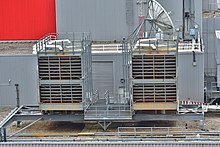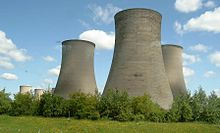



A cooling tower is a device that rejects waste heat to the atmosphere through the cooling of a coolant stream, usually a water stream, to a lower temperature. Cooling towers may either use the evaporation of water to remove heat and cool the working fluid to near the wet-bulb air temperature or, in the case of dry cooling towers, rely solely on air to cool the working fluid to near the dry-bulb air temperature using radiators.
Common applications include cooling the circulating water used in oil refineries, petrochemical and other chemical plants, thermal power stations, nuclear power stations and HVAC systems for cooling buildings. The classification is based on the type of air induction into the tower: the main types of cooling towers are natural draft and induced draft cooling towers.
Cooling towers vary in size from small roof-top units to very large hyperboloid structures that can be up to 200 metres (660 ft) tall and 100 metres (330 ft) in diameter, or rectangular structures that can be over 40 metres (130 ft) tall and 80 metres (260 ft) long. Hyperboloid cooling towers are often associated with nuclear power plants,[1] although they are also used in many coal-fired plants and to some extent in some large chemical and other industrial plants. The steam turbine is what necessitates the cooling tower. Although these large towers are very prominent, the vast majority of cooling towers are much smaller, including many units installed on or near buildings to discharge heat from air conditioning. Cooling towers are also often thought to emit smoke or harmful fumes by the general public and environmental activists, when in reality the emissions from those towers mostly do not contribute to carbon footprint, consisting solely of water vapor.[2][3]
- ^ "Identifying Nuclear Reactors in Google Earth". CleanEnergy Footprints (cleanenergy.org). 31 December 2012. Archived from the original on 23 October 2014. Retrieved 19 May 2014.
- ^ "Myth of cooling towers is symptomatic of global warming information shortage". Royal Society of Chemistry. 15 February 2007. Retrieved 2 March 2022.
- ^ "What you need to know about nuclear cooling towers". Duke Energy | Nuclear Information Center. 24 July 2017. Retrieved 2 March 2022.